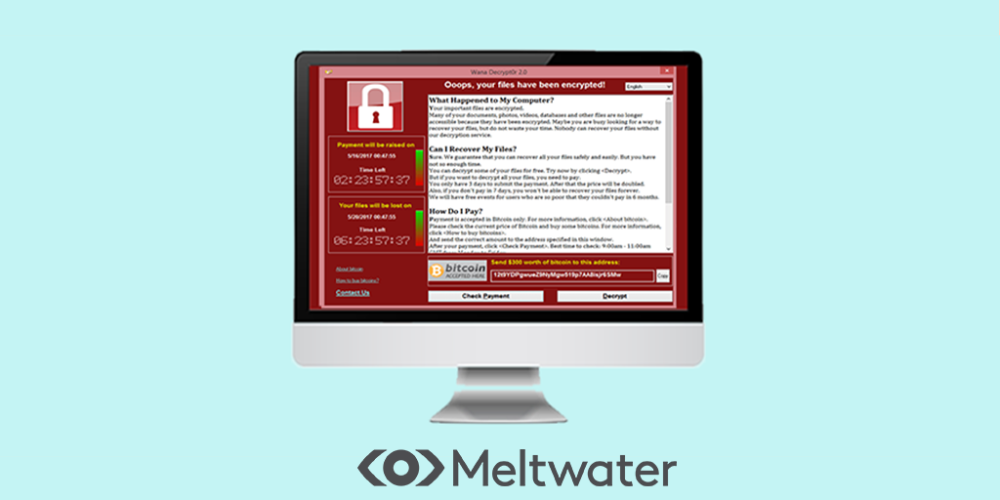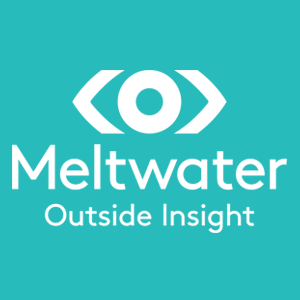Data Analysis: Online coverage of NHS Cyber-Attack & What to do if Youâre Hit by a Crisis.
06 Jun 2017

As the world continues to shift to digital the threat of cyber-attacks from malicious software get stronger by the day.
Businesses worldwide were recently hit with a large-scale cyber-attack dubbed “WannaCry”. The ‘ransomware’ caused absolute chaos globally. Once WannaCry took over the user’s PC, those affected were told they had 3 days to cough up bitcoins to retrieve their now inaccessible files… or they will be deleted forever.
NHS hospitals across the UK in particular took a bashing from WannaCry. Some couldn’t access patient data, and other had to cancel operations and divert ambulances.
In this post we’ll be looking at the impact of the digital response to the WannaCry crisis and suggest the best response PR professionals should take if ever they land themselves in “worse case” scenarios.
Using social media monitoring to understand the impact
Using Meltwater’s media monitoring tool, we were able to search and listen for the term “NHS” and ‘national health service’ alongside keywords related to the WannaCry ransomware.
54,543
Number of online news mentions of the NHS and the recent cyber-attack (12/05/17-22/05/17)
64,318
Number of social mentions of the NHS and the recent cyber-attack (12/05/17-22/05/17)
In the 10 days following the news of the virus there was thousands of mentions both on social media and in the online news. 118,861 total mentions. That’s an awful lot over 10 days!
Media Monitoring: analyse media exposure

Here we can see the huge spike in both news and social coverage. The National Health Service, alongside computer virus related keywords coverage skyrocketed overnight. We saw coverage surge from only 108 mentions the day before the malware, to 28.35k social media posts when it first hit.
It’s not surprising that such an incident generated so much coverage, however by using our media monitoring platform we found out some surprising insights from the analysis too!
Media Monitoring: Analyse trending themes, sentiment and location of posters.

Here’s the dashboard we quickly created using Meltwaters media monitoring tool.
Here’s some interesting pieces of data we pulled out of our media monitoring platform…
Posts with the highest potential reach
- Top Reaching Article: 71 million- ‘NHS hospitals in England hit by widespread ransomware attack’
- Top Reaching Facebook post: 42 million- ‘The cyber attack that paralyses computer systems belonging to the NHS and many organisations around the biggest of its kind’ –
- Top Reaching Tweet: 32 million- NHS services across England hit by IT failure, believed to be caused by a large-scale cyber attack
Which countries talked about NHS cyber-attack?
- UK: 18,019 news mentions
- USA: 19,943 news mentions
- France: 1501 news mentions (even when we only searched in English)
- India: 1411 news mentions
- Australia: 1156 news mentions
Wordcloud of internationally trending themes

Wordcloud with trending themes in the US.

Why did America write so many articles mentioning the NHS and the ransomware?
Based on the trending themes of coverage across America, articles focused on preventing being infected by ransomware, speculation of who might be behind it and the worldwide impact of the virus.
Sentiment of coverage:

Posts mentioning ‘NHS’ or ‘national health service’ on day of crisis.
So we’ve been hit by a crisis, now what?
Once a story has erupted online, it spreads like wildfire and there’s not much we can do to prevent people from seeing it. Rather than hiding away until the crisis is over, we should aim for a prompt, informative response. This will begin damage control, put the story straight (if needed) and reassure our stakeholders of the next steps.
Assess the situation
So, how bad is it? Hopefully we have some first-hand insights from those involved in the issue. E.g. staff who have seen the virus and the affects of it. Also use media monitoring to understand how news outlets and the general public are responding to the news. Like the NHS analysis above, tracking the media exposure of posts can indicate just how viral the news is going.
Know your audience
Who is the crisis going to impact? Using the NHS as an example, one of the biggest concerns from the general public was patient data rather than cancelled appointments etc. We can track commonly mentioned keywords using our social media monitoring tool. By doing so, we’re able to easily detect keywords that may indicate initial worries from the public.The chart below goes into more depth about identifying audiences and how they’re likely to react.
Get your message heard
Now we know who the crisis will affect, we need to respond to stakeholders. Keeping all the above in mind now it’s time to begin communicating our message. A response statement can help provide information and reassure concerned customers and/or investors. Having a strong relationship with key media will significantly help. Find out how you can connecting and building lasting bonds with influencers here. We may wish to implement paid adverts that target those affected, send out emails, and use social media to communicate with our audience.
Measure the impact of your statements and posts as you go
How are our updates being received? Media monitoring enables us to track how people are responding and how sentiment is shifting. If we send a press release through Meltwater’s PR distribution tool, we can also track how many people opened the release as well as the amount of time they spent reading it.
Know when to stop
As we saw with the media exposure graph for the NHS, online buzz does eventually settle down. The amount of time it takes to do so varies depending from crisis to crisis. When spikes begin to dramatically drop, it’s time for us stop reminding everyone of what happened and start to rebuild value. Further to this, remember we can never please everyone. After we make all the points we can make, then stop responding to detractors, especially if they’re trolls with little influence.
Prevention
Maybe we can avoid the same thing happening again. Part of the reason the NHS was affected by the malware was that many hospitals didn’t have backups of their data, nor were their systems up to date. This left them vulnerable to an attack, and then unable to do much about it. The lesson we can learn from this, is the importance of online security- updating our computers and making backups is essential. Sometimes, crisis are very difficult to prevent, and so we should also have an in depth crisis preparation plan in place for “just in case” purposes.
Download our eBook ‘Media Intelligence for Crisis Communications’ full of tips on how to create a crisis prevention plan and how to address a crisis- as well as when to work with legal advisors.


Please login to comment.
Comments